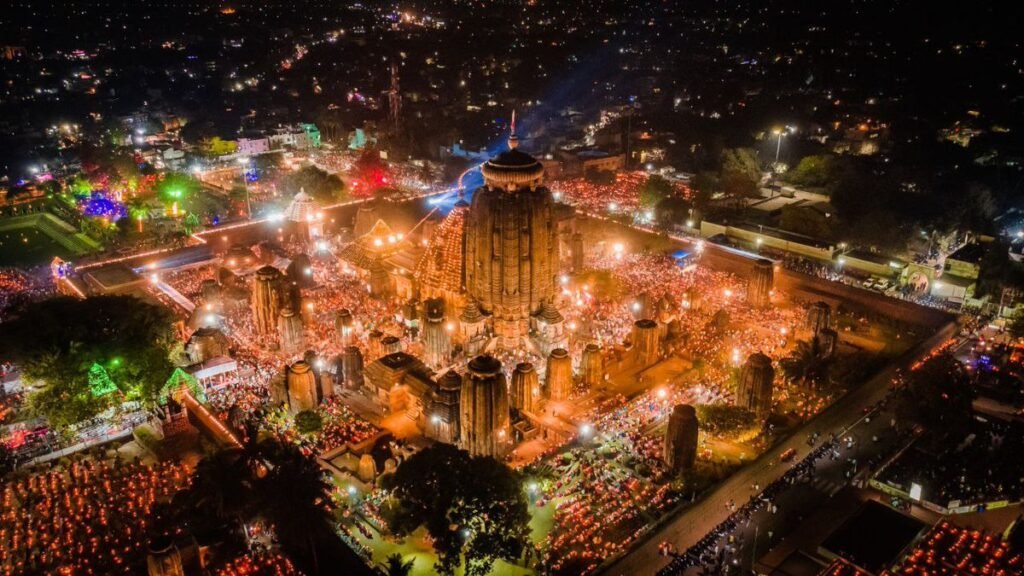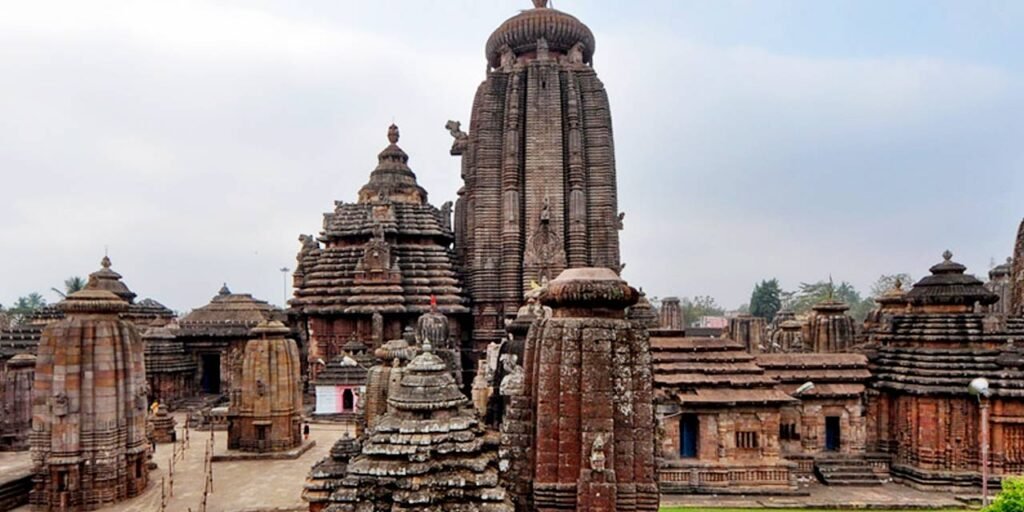
Table of Contents
Introduction of Lingaraj temple
The Lingaraj Temple is a renowned Hindu temple situated in Bhubaneswar, the capital city of Odisha, India. Dedicated to Lord Shiva, this temple stands as a testament to the rich cultural and architectural heritage of the region. Its historical significance, architectural splendor, and religious devotion make it a prominent pilgrimage site and a captivating tourist destination.
The temple’s towering spire, intricate carvings, and the sacred Bindusagar pond reflect the artistic brilliance of the Kalinga architectural style. With a history that dates back over a thousand years, the Lingaraj Temple has witnessed the ebb and flow of time, remaining a center of worship and spirituality.
Throughout the year, the temple attracts countless devotees who seek blessings and solace within its hallowed walls. The air comes alive during festive occasions, such as Shivaratri, when the temple reverberates with fervent prayers, vibrant rituals, and a profound sense of devotion.
As a living embodiment of Odisha’s cultural heritage and religious devotion, the Lingaraj Temple continues to stand as a symbol of unwavering faith and architectural grandeur.

Lingaraj temple History
he history of the Lingaraj Temple spans over a millennium and is richly intertwined with the cultural, religious, and architectural evolution of the region. This monumental temple holds within its walls a tapestry of stories, spanning from its inception to its present-day significance.
Ancient Origins and Foundation: The Lingaraj Temple finds its origins in the ancient city of Bhubaneswar, which was historically known as Ekamra Kshetra. The city itself has a deep association with Hinduism and Jainism, with numerous temples and religious sites. The temple’s foundation dates back to around the 7th century when the region was under the rule of the Eastern Ganga dynasty.
The temple’s construction is attributed to King Jajati Keshari, a ruler of the Ganga dynasty. The original temple was relatively modest in scale and design, reflecting the architectural style of that era. It was dedicated to Lord Shiva, who is revered as the presiding deity in the Lingaraj Temple.
Evolution and Expansion: Over the centuries, the temple underwent several phases of expansion, renovation, and architectural embellishments. The Kalinga style of architecture, known for its intricate carvings and sculptural details, took root and flourished in this region. This style is characterized by the pyramid-shaped spire, heavily ornamented walls, and sanctum interiors adorned with exquisite carvings.
As different dynasties and rulers came to power, the Lingaraj Temple witnessed phases of patronage, resulting in structural improvements and artistic additions. The temple’s spire, or “vimana,” gradually grew taller and more elaborate, becoming a distinctive feature of the temple’s skyline.
Dynastic Influence: The temple’s history is intertwined with the rise and fall of various dynasties that ruled Odisha. The Bhaumakara dynasty, for instance, left a significant mark on the temple’s architecture. Subsequent dynasties like the Somavamsi dynasty and the Gajapati rulers continued to contribute to the temple’s development, expanding its precincts and embellishing its facade.
Spiritual and Cultural Significance: The Lingaraj Temple emerged not only as an architectural marvel but also as a spiritual and cultural epicenter. Devotees from different parts of India flocked to the temple to seek blessings and divine intervention. The temple complex became a hub of religious activities, festivals, and cultural events. The annual Shivaratri festival, in particular, drew large crowds, transforming the temple into a vibrant and bustling center of worship.
Colonial Period and Preservation: The Lingaraj Temple, like many other historic sites, faced challenges during the colonial period. British authorities recognized its architectural significance and initiated efforts to preserve and protect it. However, the temple did suffer some damage during this time due to neglect and lack of resources.
Modern Restoration and Conservation: In the post-independence era, there was a renewed focus on preserving India’s cultural heritage. The Lingaraj Temple underwent restoration and conservation efforts to safeguard its architectural integrity and historical importance. These efforts involved architectural experts, historians, and local authorities collaborating to ensure the temple’s longevity.
Architectural Splendor and Carvings: The Lingaraj Temple’s architecture stands as a testament to the skill and creativity of ancient artisans. Intricate carvings on the walls depict scenes from Hindu mythology, showcasing stories of gods, goddesses, and epic narratives. The temple’s inner sanctum houses the lingam, a symbolic representation of Lord Shiva, further intensifying its spiritual aura.
Religious Practices and Devotion: Devotees from various walks of life continue to visit the Lingaraj Temple to offer their prayers and seek blessings. The temple’s priests conduct elaborate rituals, ceremonies, and prayers, upholding the traditions that have been followed for centuries.
Cultural Continuity: Throughout its history, the Lingaraj Temple has stood as a living testament to the cultural continuity of Odisha. It embodies the region’s spiritual ethos, architectural brilliance, and the deep-rooted reverence for Lord Shiva.
Contemporary Significance: In the modern era, the Lingaraj Temple remains a vital pilgrimage site and a significant tourist attraction. Its architectural magnificence and religious importance draw visitors from across India and the world, providing a glimpse into the rich heritage of Odisha.
In conclusion, the Lingaraj Temple’s history is a journey through time, reflecting the ebb and flow of dynasties, architectural styles, and religious practices. Its enduring presence serves as a link between the past and the present, reminding us of the rich cultural tapestry that continues to shape our world today.
also readHistory of Odisha :A brief overview
Timing of the Lingaraj temple
Timing of the Lingaraj Temple: Preserving Sacred Routines and Spiritual Experiences
The Lingaraj Temple, an iconic Hindu shrine nestled in Bhubaneswar, Odisha, follows a meticulously structured timing schedule. This schedule is designed to harmonize the temple’s religious rituals, pilgrim influx, maintenance activities, and the overall spiritual atmosphere. Let’s delve into the timing of the Lingaraj Temple, exploring its different phases and the significance of each.
1. Dawn Awakening: 5:00 AM – 6:00 AM
The temple doors swing open as the first light of dawn graces the horizon. This initial hour caters to early risers and devotees eager to begin their day with a serene and soulful connection to Lord Shiva. The quietude of dawn allows for personal introspection and meditation.
2. Morning Devotions: 6:00 AM – 12:00 PM
As the sun rises higher, the temple becomes a hub of spiritual activity. Devotees, both locals and tourists, stream in to offer prayers and seek blessings. The temple priests conduct a series of rituals during this period, infusing the temple with a divine aura. The chanting of sacred hymns and the ringing of bells add to the sanctity of the space.
3. Midday Contemplation: 12:00 PM – 3:00 PM
The afternoon hours offer a relatively quieter time for visitors to explore the temple’s architectural intricacies and historical significance. This phase allows for a deeper understanding of the temple’s cultural and spiritual importance, away from the bustling morning hours.
4. Afternoon Reverence: 3:00 PM – 5:00 PM
The temple sees a resurgence of activity in the late afternoon. Devotees returning from their daily activities gather to participate in rituals and prayers. The temple complex resonates with the earnestness of devotees seeking blessings and solace.
5. Evening Illumination: 5:00 PM – 9:00 PM
As the sun dips below the horizon, the Lingaraj Temple is illuminated with oil lamps and incense. The evening aarti commences, characterized by the offering of light and melodious hymns. The entire temple comes alive with the collective devotion of worshippers. The divine ambiance is heightened by the flickering flames and the melodic cadence of prayers.
6. Special Occasions and Festivals
During festivals and auspicious days, the Lingaraj Temple’s timing may deviate from the usual schedule. Festivals like Shivaratri witness extended opening hours, allowing devotees to engage in round-the-clock worship and celebrations. These occasions bring forth a heightened sense of devotion and cultural fervor.
7. Timing Variations and Updates
It’s essential to acknowledge that the timing of the Lingaraj Temple might undergo occasional variations. Seasonal changes, religious observations, and local customs could impact the temple’s opening and closing hours. Visitors are advised to stay informed about any timing changes by checking with temple authorities or local guides.
the timing of the Lingaraj Temple is a well-thought-out framework that strives to accommodate the spiritual needs of its devotees while offering a glimpse into its awe-inspiring architecture and historical significance for visitors. Each phase of the temple’s timing encapsulates a unique aspect of the temple’s essence, fostering a profound connection between the divine and the earthly realms.
Conclusion
In the heart of Bhubaneswar, Odisha, the Lingaraj Temple stands as a beacon of spiritual devotion, cultural heritage, and architectural magnificence. Its timing schedule, meticulously crafted through the ages, serves as a guide for the seamless flow of devotion, rituals, and exploration within its hallowed premises.
From the tranquil hours of dawn, when the first rays of sunlight touch the temple’s walls, to the evening’s vibrant glow as oil lamps illuminate the sanctum, each phase of the temple’s timing is an invitation to connect with the divine. The timing not only accommodates the religious routines but also provides visitors with the opportunity to immerse themselves in the temple’s intricate carvings, historical significance, and the sense of continuity that bridges the past with the present.
The Lingaraj Temple’s timing, like the rhythms of life, adapts to special occasions and festivals, uniting devotees in their shared reverence. As the temple resonates with the echoes of hymns, the fragrance of incense, and the gentle cadence of rituals, it fosters an atmosphere of profound spirituality.
However, amidst its structured timing, there lies a reminder of the impermanence of time itself. Seasons change, customs evolve, and the temple continues its timeless journey through history. This recognition underscores the importance of staying informed about any timing variations, allowing visitors to experience the temple’s offerings to the fullest.
In conclusion, the timing of the Lingaraj Temple is a carefully woven tapestry that enlivens the spiritual experience for devotees and enthusiasts alike. It is a rhythmic symphony that echoes through the corridors of devotion, reminding us that within the embrace of these sacred walls, moments of connection with the divine are timeless and eternal.
FAQs
Q1: Where is the Lingaraj Temple located?
A1: The Lingaraj Temple is located in Bhubaneswar, the capital city of Odisha, India.
Q2: Who is the presiding deity of the Lingaraj Temple?
A2: The presiding deity of the Lingaraj Temple is Lord Shiva, worshipped in the form of Lord Harihara, a combined manifestation of Shiva and Vishnu.
Q3: What is the architectural style of the Lingaraj Temple?
A3: The Lingaraj Temple is built in the Kalinga style of architecture, characterized by its intricate carvings, pyramid-shaped spire, and ornate details.
Q4: What are the temple’s opening and closing timings?
A4: The temple’s timings can vary, but it generally opens in the early morning around sunrise and remains open throughout the day until the evening aarti, which is typically held around 5:00 PM – 9:00 PM. However, visitors are advised to check with temple authorities for the most accurate and up-to-date timings.
Q5: Can non-Hindus visit the Lingaraj Temple?
A5: Yes, the Lingaraj Temple is open to people of all faiths and backgrounds. However, visitors are expected to respect the temple’s religious customs and practices.
Q6: Is photography allowed inside the temple premises?
A6: Photography may be restricted in certain areas of the temple premises, particularly around the sanctum and during rituals. It’s advisable to ask for permission or guidance from temple staff before taking photographs.
Q7: Are there any festivals celebrated at the Lingaraj Temple?
A7: Yes, the Lingaraj Temple celebrates various Hindu festivals, with Shivaratri being one of the most prominent. During festivals, the temple experiences an increased number of visitors and hosts special rituals and cultural events.
Q8: Is there an entry fee to visit the temple?
A8: The entry to the Lingaraj Temple is generally free. However, there might be charges for specific services or facilities, such as guided tours or photography.
Q9: Is there a dress code for visitors?
A9: While there might not be a strict dress code, it’s recommended to dress modestly and respectfully when visiting the temple. Wearing attire that covers shoulders and knees is generally considered appropriate.
Q10: How can I reach the Lingaraj Temple?
A10: The temple is located in the heart of Bhubaneswar, making it easily accessible by various modes of transportation, including buses, taxis, and auto-rickshaws.
Remember that information may change, so it’s a good idea to verify details before your visit.
https://en.wikipedia.org/wiki/Lingaraja_Temple





